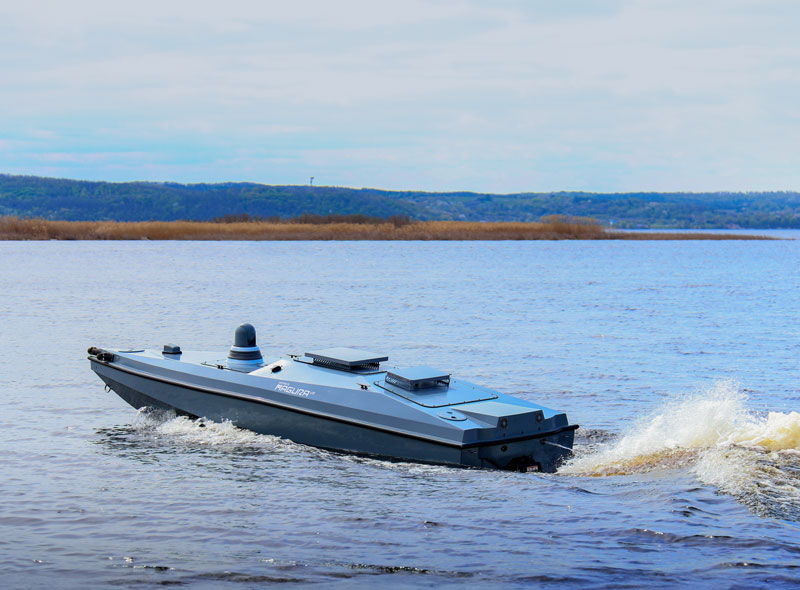
The manoeuvrability of a MAGURA V5, a Ukrainian unmanned surface vehicle, is demonstrated in April 2024. Ukraine has used such drones to attack Russian vessels. [Alamy/2X17XJ0]
General Valery Zaluzhny, relieved of his command of the Ukrainian forces this past February, was blunt in remarks he made to The Economist in November 2023.
“Just like in the First World War we have reached the level of technology that puts us into a stalemate,” he said. “There will most likely be no deep and beautiful breakthrough.”
What was the problem affecting both his troops and those of the Russians? Modern technology, including the expansive use of drones and the ability to jam them, and precision weapons were preventing troops from breaching enemy lines.
“We need to ride the power embedded in new technologies,” he said.
Drones had changed the battle space, Zaluzhny correctly believed, and they were present in the thousands in both the Ukrainian and Russian arsenals. In September 2023, Ukraine was using about 10,000 a month; by December, the soldiers in the field were employing 50,000 drones of all types. The government’s aim was to have one million drones on hand by the end of 2024.
For its part, Moscow claimed to be producing 300,000 drones a month and it was also importing drones from Iran—paid for in gold. How the Russians were building so many, given their shortage of computer chips, was unclear, though holes in the West’s sanctions and Chinese exports were likely responsible. (One media source claimed that Canadian components were found in a downed Russian drone.) And Moscow’s drones weren’t all inexpensive—its Lancets, with a purported range of 40 kilometres, cost an estimated US$35,000 each.
Russian forces used their drones to attack Ukrainian entrenchments and dugouts at the front, clearing the way for infantry assaults. They also used them to attack civilian sites such as apartment buildings, hotels and markets—war crimes in a war being waged in many illegal ways.
The manoeuvrability of a MAGURA V5, a Ukrainian unmanned surface vehicle, is demonstrated in April 2024. Ukraine has used such drones to attack Russian vessels.
The Ukrainians, by and large, were more discreet in employment of their weaponry. They used so-called “kamikaze” loitering munitions, which can fly above the battleground until a suitable target—a tank or armoured personnel carrier, for instance—appears, then crash into it and explode, destroying both the drone and wrecking or disabling whatever it hits. These first-person view drones, controlled by operators from miles away, can also spy a tank with its hatch open, and drop a small bomb into it, killing its crew. It can then return to its base and be used again the next day. Drone attacks on armour and artillery were, the Ukrainian military claimed, outpacing the Russian ability to produce replacements, and killing or wounding experienced soldiers in large numbers. Russia had suffered nearly 480,000 casualties in Ukraine by May 2024.
The Ukrainians have also developed seaborne drones that can attack naval targets. These drones, resembling small speedboats, can sink large vessels such as corvettes and submarines, and their successes effectively made the western Black Sea a no-go area for the Russian navy. This was important because it allowed Ukraine to safely resume grain exports, a critical source of revenue for Kyiv and an important food source for African nations.
And, as Ukrainian drones became more effective and capable of longer ranges, Kyiv launched attacks on Moscow, St. Petersburg and oil production and storage sites throughout Russia, the latter significantly impacting the major oil producer and exporter. Ukrainian attacks in January 2024 cut Russia’s gas exports by 37 per cent and diesel exports by 23 per cent, worsening Moscow’s already weak financial position. The destruction of the one large refinery on the Black Sea coast also hampered operations of what remained of the Russian fleet there.
What’s now clear to observers in every military, is that drones have changed warfare.
Both sides also relied on electronic countermeasures to stop such attacks (and the anti-drone sites were, of course, prime targets). Each country regularly claimed to have identified and destroyed large numbers of invading drones. On Feb. 7, for example, the Ukrainians said they shot down 15 of 20 drones launched at them and used their electronic warfare systems to seize control of an incoming drone and safely land it.
At the same time, the use of drones in reconnaissance was massively impacting the battlefield. Airborne surveillance pinpointed the location of enemy targets, thus increasing the accuracy of missile strikes. The Ukrainians relied on HIMARS—High Mobility Artillery Rocket Systems—supplied by the United States and some other NATO countries. HIMARS were expensive, but the system’s missiles, launched from a truck, are extremely accurate (within a metre from 300 kilometres away), and drone reconnaissance meant that they were unlikely to miss their target.
Moreover, and even more importantly, recce by drones ostensibly prevented any large massing of weaponry and/or troops, thereby preventing surprise attacks. This made last summer’s Ukrainian offensive unsuccessful. But, it also forced the Russians into using so-called “meat assaults,” in which they sent small groups of infantry, sometimes supported by armour, repeatedly into Ukrainian defences until, aided by drone attacks on trenches, they could force a withdrawal of a few hundred metres. These assaults were extraordinarily costly in soldiers and tanks, but the Russians were willing to accept such losses.
What’s now clear to observers in every military, is that drones have changed warfare. Artillery remains decisive in battles, but drones might be on the verge of overcoming its dominance. Currently, the technology is running ahead of countermeasures that aim to defeat it.
Still, both sides in the Russo-Ukrainian War are trying to advance the development of their anti-drone defences; so, too, are the Americans, the Chinese and every country worrying about how its soldiers might fare in future conflicts.
For the sake of their men and women in uniform, Canadians should hope that Ottawa is doing the same.
Advertisement





















